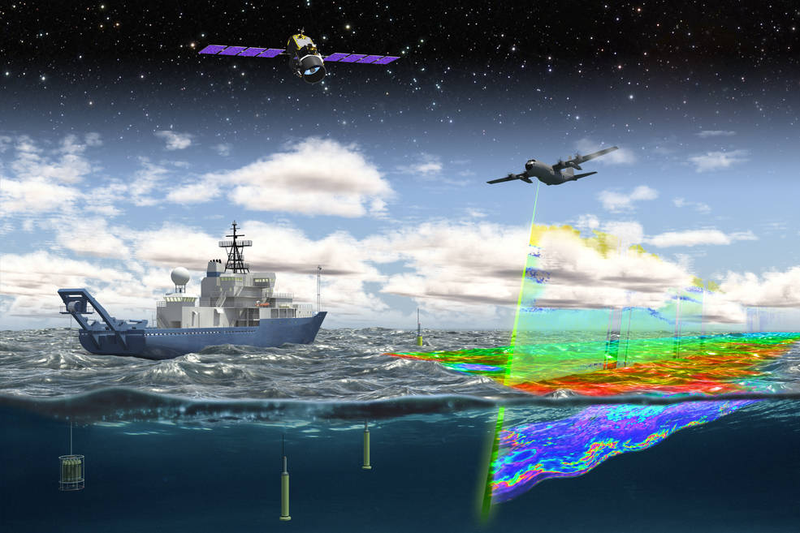Observing Sea-to-Air Aerosol Gas Fluxes Under Extreme Weather Conditions
Observing Sea-to-Air Aerosol Gas Fluxes Under Extreme Weather Conditions
NAAMES was the first NASA Earth Venture – Suborbital mission focused on studying the coupled ocean ecosystem and atmosphere. NAAMES utilized a combination of ship-based, airborne, autonomous sensor, and remote sensing measurements that directly linked ocean ecosystem processes, emissions of ocean-generated aerosols and precursor gases, and subsequent atmospheric evolution and processing.
The four deployments targeted different phases of the phytoplankton bloom cycle to understand the temporal patterns of phytoplankton blooms. These blooms are tied to marine aerosol-cloud-climate interactions, as phytoplankton are capable of producing organic compounds that can become aerosols.
Datasets
The NAAMES field campaign was an investigation of the key processes controlling ocean ecosystems and aerosols. Ship-based data from the Research Vessel Atlantis (R/V Atlantis) was used to complement airborne data collected using NAAMES C-130. Severe weather conditions during this event prevented overboard deployments and access to the weather decks. However, instruments aboard the R/V Atlantis measuring in-situ aerosols and trace gases still were able to collect data. NAAMES data can be accessed on Earthdata Search.

Spatial Coverage:
[N: 57, W: 70, E: 40, S: 40] degrees
Temporal Coverage:
May 30, 2016
Phenomena Studied
Events of Interest
This section highlights events within the field campaign of particular scientific interest.
How does an extreme weather system impact sea-to-air aerosol gas fluxes?
After mostly favorable weather conditions through the second field campaign of the North Atlantic Aerosols and Marine Ecosystems Study (NAAMES), an extreme weather system on May 30, 2016 provided a unique opportunity for scientists to measure atmospheric phenomena at sea. The high wind speeds and large waves – in some cases up to 30 feet – prevented those aboard the Research Vessel Atlantis (R/V Atlantis) from accessing the deck of the ship. Some instruments on the deck of the R/V Atlantis were damaged, shifted, or lost during the storm. Despite posing hazardous conditions, the storm provided researchers with a unique opportunity to enhance their research by measuring sea-to-air aerosol gas fluxes in a severe weather event. The measurement of sea-to-air aerosol gas fluxes quantifies aerosols as they move from the ocean into the air, and these aerosol gas fluxes can be impacted by environmental disturbances such as a severe weather event. Aerosols play an important role in cloud formation in marine environments. Understanding the forces that form marine aerosols may inform future hypotheses and/or conclusions about the interactions between the ocean and atmosphere.

The storm produced strong waves similar to this one, which were sometimes up to thirty feet. Photo Credits: NASA/Christien Laber

The high wind speed and waves damaged some of the equipment on board. Photo Credits: NASA/Christien Laber
Relevant Publications
Behrenfeld, M. J., Moore, R. H., Hostetler, C. A., Graff, J., Gaube, P., Russell, L. M., Chen, G., Doney, S. C., Giovannoni, S., Liu, H., Proctor, C., Bolaños, L. M., Baetge, N., Davie-Martin, C., Westberry, T. K., Bates, T. S., Bell, T. G., Bidle, K. D., Boss, E. S., … Ziemba, L. (2019). The North Atlantic Aerosol and Marine Ecosystem Study (NAAMES): Science Motive and Mission Overview. Frontiers in Marine Science, 6. https://doi.org/10.3389/fmars.2019.00122
Reference Sources
Boss, L. K. (2016, May 30). NAAMES II Expedition – May 30th. NASA Earth Observatory, Notes from the Field. https://earthobservatory.nasa.gov/blogs/fromthefield/2016/05/31/naames-ii-expedition-may-30-2016/
Atmospheric Science Data Center (ASDC)
NAAMES General Microarticle
